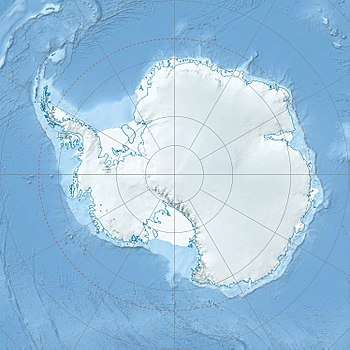Forrestal Range
The Forrestal Range (83°00′S 049°30′W) is a largely snow-covered mountain range, about 105 km (65 mi) long, standing east of Dufek Massif and the Neptune Range in the Pensacola Mountains of Antarctica. Discovered and photographed on January 13, 1956 on a transcontinental patrol plane flight of U.S. Navy Operation Deep Freeze I from McMurdo Sound to the vicinity of the Weddell Sea and return.[1]

Named by the US-ACAN after USS Forrestal, first supercarrier of the U.S. Navy. The entire Pensacola Mountains were mapped by USGS in 1967 and 1968 from U.S. Navy tricamera aerial photographs taken in 1964.[1]
Key mountains
- Abele Spur (83°13′S 51°5′W) is a rock spur that descends west from Mount Lechner toward the Herring Nunataks. It was named by US-ACAN at the suggestion of Arthur B. Ford for Gunars Abele, civil engineer on the 1973–1974 United States Antarctic Research Program (USARP)-CRREL survey in this area.[2]
- Blount Nunatak (83°16′S 51°19′W) is a prominent nunatak, 1,630 m (5,350 ft), standing 3 nautical miles (5.6 km) southwest of Mount Lechner on the west side of Forrestal Range. Discovered and photographed on January 13, 1956 during a U.S. Navy transcontinental nonstop plane flight from McMurdo Sound to Weddell Sea and return. Named by US-ACAN for Hartford E. Blount, aviation machinists mate with U.S. Navy Squadron VX during Operation Deep Freeze, 1956.[3]
- Cooke Crags (83°10′S 50°43′W) are rock crags on the ice slope between Henderson Bluff and Mount Lechner on the west side of Lexington Table. The area was mapped by USGS from surveys and U.S. Navy aerial photographs, 1956–1966. Named by US-ACAN in 1979 after James E. Cooke, USGS geophysicist who worked in Forrestal Range and Dufek Massif, 1978–1979.[4]
- Mount Lechner 83°14′S 50°55′W is a prominent mountain, 2,030 m (6,660 ft), surmounting the southwest end of Saratoga Table. Mapped by USGS from surveys and U.S. Navy air photos, 1956–1966. Named by US-ACAN for Major Ralph C. Lechner, USA, airlift coordinator on the staff of the Commander, U.S. Naval Support Force, Antarctica, 1964–1966.[5]
- Watts Summit (83°12′S 50°31′W) is a peak rising to 1,785 m (5,856 ft) in the southwestern corner of Lexington Table. Mapped by USGS in 1967 from ground surveys and U.S. Navy aerial photographs taken 1964. Named in 1979 by US-ACAN after Raymond D. Watts, USGS geophysicist who worked in the Forrestal Range and Dufek Massif, 1978–1979.[6]
- Mount Zirzow (83°8′S 49°6′W) is a mountain, 1,615 m (5,299 ft), standing 4 miles (6.4 km) north of Mount Mann on the east edge of Lexington Table. Mapped by USGS from surveys and U.S. Navy air photos, 1956–1966. Named by US-ACAN for Commander Charles F. Zirzow, U.S. Navy, Assistant Chief of Staff to the Commander, U.S. Naval Support Force, Antarctica, 1966–1967.[7]
Key geographical features
- Lexington Table (83°05′S 49°45′W) is a high, flat, snow-covered plateau, about 15 miles (24 km) long and 10 miles (16 km) wide, standing just north of Kent Gap and Saratoga Table. Discovered and photographed on January 13, 1956 on a transcontinental nonstop flight by personnel of U.S. Navy Operation Deep Freeze I from McMurdo Sound to the vicinity of Weddell Sea and return. Named by US-ACAN for USS Lexington of 1926, one of the first large aircraft carriers of the U.S. Navy.[8]
- Saratoga Table (83°20′S 50°30′W) is a high, flat, snow-covered plateau, 8 miles (13 km) long and 6 miles (9.7 km) wide, standing just south of Kent Gap and Lexington Table. Discovered and photographed on January 13, 1956 on a transcontinental nonstop flight by personnel of U.S. Navy Operation Deep Freeze I from McMurdo Sound to the vicinity of Weddell Sea and return. Named by US-ACAN for USS Saratoga of 1926, one of the first large aircraft carriers of the U.S. Navy.[9]
Features
Geographical features include:
- Ackerman Nunatak
- Beiszer Nunatak
- Burmester Dome
- Butler Rocks
- Camp Spur
- Chambers Glacier
- Coal Rock
- Creaney Nunataks
- Crouse Spur
- Dyrdal Peak
- Erlanger Spur
- Fierle Peak
- Ford Ice Piedmont
- Franko Escarpment
- Gabbro Crest
- Grob Ridge
- Haskill Nunatak
- Henderson Bluff
- Herring Nunataks
- Hodge Escarpment
- Huie Cliffs
- Kent Gap
- Kovacs Glacier
- Lance Rocks
- Larson Nunataks
- Magnetite Bluff
- Mathis Spur
- May Valley
- McCauley Rock
- Median Snowfield
- Mount Hook
- Mount Hummer
- Mount Malville
- Mount Mann
- Mount Stephens
- Ray Nunatak
- Ritala Spur
- Ronald Rock
- Sallee Snowfield
- Sheriff Cliffs
- Skidmore Cliff
- Sorna Bluff
- Support Force Glacier
- Thompo Icefall
- Vanguard Nunatak
- Vigen Cliffs
References
- "Forrestal Range". Geographic Names Information System. United States Geological Survey. Retrieved 2004-11-03.
- "Abele Spur". Geographic Names Information System. United States Geological Survey. Retrieved 2008-03-23.
- "Blount Nunatak". Geographic Names Information System. United States Geological Survey. Retrieved 2010-11-07.
- "Cooke Crags". Geographic Names Information System. United States Geological Survey. Retrieved 2010-11-07.
- "Mount Lechner". Geographic Names Information System. United States Geological Survey. Retrieved 2005-11-11.
- "Watts Summit". Geographic Names Information System. United States Geological Survey. Retrieved 2010-11-07.
- "Mount Zirzow". Geographic Names Information System. United States Geological Survey. Retrieved 2008-03-20.
- "Lexington Table". Geographic Names Information System. United States Geological Survey. Retrieved 2010-11-07.
- "Saratoga Table". Geographic Names Information System. United States Geological Survey. Retrieved 2010-11-07.
![]()